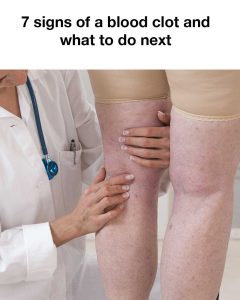
Understanding Blood Clots
Blood clots are a serious medical condition that can pose significant health risks if not detected and treated promptly. While blood clotting is a natural and essential process for stopping bleeding when we get injured, it becomes problematic when it occurs unexpectedly or inappropriately. In some cases, blood clots form inside the body without an injury, blocking normal blood flow. This can lead to dangerous conditions such as deep vein thrombosis (DVT) and pulmonary embolism (PE). DVT occurs when a clot forms in a deep vein, usually in the legs, while a pulmonary embolism occurs when a clot breaks loose and travels to the lungs, disrupting blood flow and potentially causing severe damage.
Although blood clots may not always cause immediate symptoms, they can quickly escalate into a life-threatening emergency if not addressed. Recognizing the early warning signs of a clot can be crucial for seeking medical attention before it causes irreversible harm. Common signs of blood clots include swelling, pain, changes in skin color, and shortness of breath. Each of these symptoms is a signal from your body that something isn’t quite right and needs attention.
This article aims to help you understand the critical signs of a blood clot and what to do if you suspect one. By recognizing these symptoms early and knowing when to seek medical help, you can significantly improve your chances of avoiding severe complications and ensure better health outcomes. Whether you are at risk for blood clots or simply want to be more informed, understanding the signs and taking timely action could make all the difference.
Seven Common Signs of a Blood Clot
Recognizing the signs of a blood clot is vital for early intervention. Here are the seven most common symptoms:
1. Swelling in the Affected Area
Swelling, especially in the legs, is a common sign of DVT. This swelling often appears suddenly and is typically localized to one limb.
2. Pain or Tenderness
Pain, particularly in the calf or thigh, can feel like a muscle cramp and worsen with activity or time. This pain often accompanies swelling and tenderness.
3. Red or Discolored Skin
The skin over the affected area may turn red, bluish, or purple due to restricted blood flow, and it may feel warm to the touch.
4. Warmth in the Affected Area
A blood clot often causes warmth or increased sensitivity in the area where it forms due to inflammation.
5. Sudden Shortness of Breath
A clot that travels to the lungs can cause a pulmonary embolism, leading to sudden shortness of breath, dizziness, or light-headedness. This is a medical emergency.
6. Chest Pain or Discomfort
Sharp, stabbing chest pain, especially when breathing deeply or coughing, may indicate a pulmonary embolism, which requires immediate attention.
7. Rapid Pulse or Heart Rate
A rapid pulse can result from the strain on your cardiovascular system caused by a clot obstructing blood flow.
What to Do if You Suspect a Blood Clot
If you notice any of these symptoms, it’s crucial not to ignore them. Avoid massaging the affected area, as it could cause the clot to dislodge. Seek medical help immediately for proper diagnosis and treatment. Early detection is essential to prevent complications.
Seeking Medical Attention
Doctors will use imaging tests, like ultrasound, to confirm the presence of a clot and may perform blood tests. Treatment typically involves anticoagulants (blood thinners) to prevent further clotting. In more severe cases, surgery may be required.
Please Head On keep on Reading (>)
